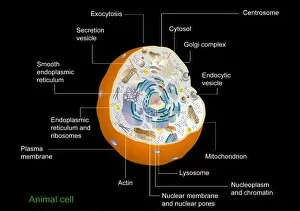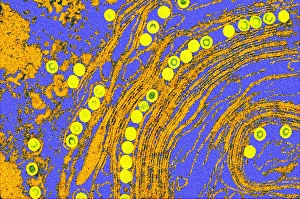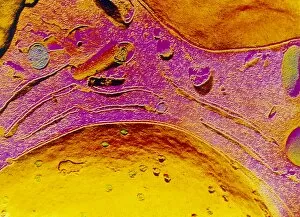Nuclear Membrane Collection
The nuclear membrane, a crucial component of eukaryotic cells, plays a vital role in maintaining cellular integrity and regulating genetic material
All Professionally Made to Order for Quick Shipping
The nuclear membrane, a crucial component of eukaryotic cells, plays a vital role in maintaining cellular integrity and regulating genetic material. When observed under a microscope, the intricate structure of this membrane becomes apparent, showcasing its importance in cell function. In a microscopic view of a cell, the nuclear membrane stands out as a prominent feature. It surrounds the nucleus like a protective barrier, separating it from the rest of the cell's components. This conceptual image of a plant cell emphasizes how the nuclear membrane acts as an essential boundary within this complex organism. Similarly, when examining an animal cell at high magnification, one cannot miss the distinct presence of the nuclear membrane. Its delicate yet robust structure encloses and safeguards DNA molecules that hold all genetic information necessary for cellular processes to occur smoothly. Comparing plant and animal cells through illustrative diagrams reveals intriguing differences in their anatomy. The comparative illustration highlights how both types possess nuclei enveloped by nuclear membranes; however, plants often have larger central vacuoles and chloroplasts absent in animal cells. Venturing into the interior realm of eukaryotic cells unveils an intricate network surrounding their nuclei: endoplasmic reticulum (ER). A conceptual image showcases ER intricately wrapping around each nucleus within plant or animal cells—a testament to its interconnectedness with other organelles for various functions such as protein synthesis and lipid metabolism. Microscopic views further emphasize our understanding of animal cells' complexity—each revealing unique features while consistently displaying well-defined nuclear membranes protecting precious genetic material inside. These images remind us that even on such small scales, life thrives with remarkable organization and purpose. Zooming out slightly from individual cells brings attention to another fascinating aspect—the interaction between viruses and host organisms at cellular levels. Microscopic views capturing both virus particles alongside infected host cells illustrate how viral invasion can disrupt normal cellular processes governed by intact nuclear membranes—an ongoing battle between pathogens seeking entry while hosts defend their vital genetic material.
















